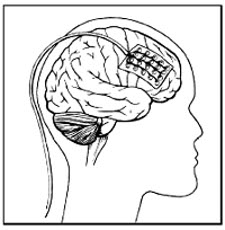Phase II Testing
What is Phase II evaluation?
Some patients have to undergo Phase II because the information from Phase I did not answer all the questions to go ahead with surgery. Phase II consists of placing special contacts on the brain during a surgery called a craniotomy which is a surgical procedure where an opening is made through the skull bone.
A craniotomy requires that all or some of your hair be shaved. You will need to have a special MRI the day before surgery. Special stickers will be placed on your head that help the surgeon during surgery. It is very important that these stickers are not taken off. You will also have blood tests done before surgery. Surgery for Phase II takes from 4 to 8 hours. (If you wish to donate your own blood to be used in surgery, you must speak with the nurse associate several weeks before surgery).
In Phase II, the neurosurgeon will place electrodes into and onto the brain. These electrodes are called "grid", "strip" or "depth" electrodes. These soft, flexible electrodes come in many sizes and shapes. After the surgeon is done, you will spend time in the recovery room and then be taken to the Intensive Care Unit for overnight observation or directly to the Epilepsy Monitoring Unit. You will have a dressing on your head while you are in Phase II.
What to expect during Phase II
During Phase II, you may stay in the hospital for 10 - 30 days. Having these special electrodes in place allows the team members to monitor your brain activity with more detail. During the monitoring period, your anti-epileptic medicines usually are decreased. Your safety is always an issue.

If needed, we will provide mittens and a vest/jacket for you to wear to keep you from pulling on the electrodes during or after a seizure. Pulling on the electrodes can be dangerous. We may require that a family member stay with you during the monitoring period if we feel you might hurt yourself by accident. A parent or other adult family member must stay with a pediatric patient during the patient's entire hospital stay.
Some patients may need functional mapping during Phase II. This includes stimulation of the contacts on the brain with a small electrical current while asking you to do certain things. This testing gives a road map for the surgeon so he knows which brain areas cannot be removed.
After evaluation
After enough seizures have been recorded in Phase II, the Surgical Epilepsy Team will decide if you are a surgical candidate. If the doctors are able to find a seizure focus, you will be taken to the operating room for electrode removal and resection of the epileptic area. Not every patient who completes Phase II can have a resection. If this is the case, you will be taken back to the operating room and will have the electrodes removed. The surgery will last four to six hours. Your recovery will follow the same course as patients who had surgery.
In some instances, we feel we have not obtained enough information for a final decision on surgical resection, but there is the suggestion that additional electrodes may answer the question. In these cases, the option of returning to the OR for placement of more electrodes will be decided.
.svg?iar=0&hash=F6049510E33E4E6D8196C26CCC0A64A4)

/hfh-logo-main--white.svg?iar=0&hash=ED491CBFADFB7670FAE94559C98D7798)